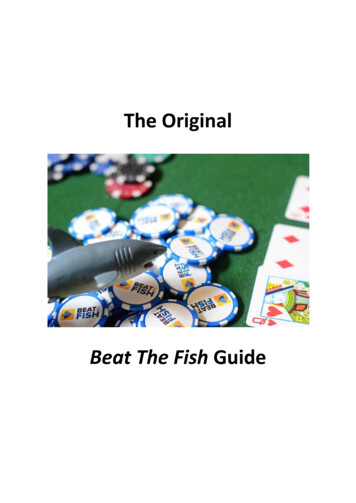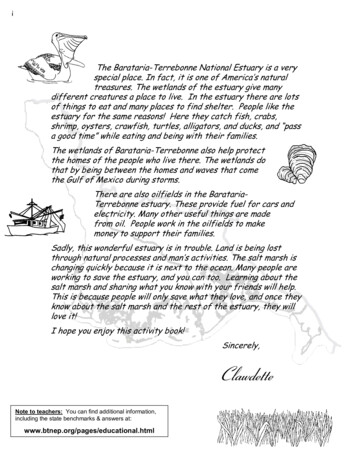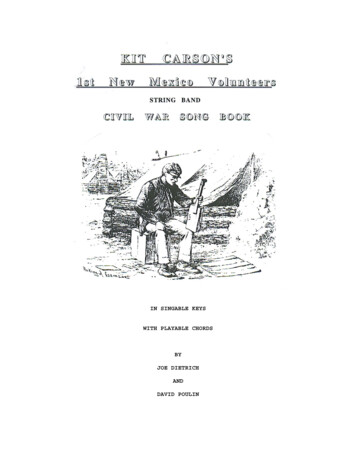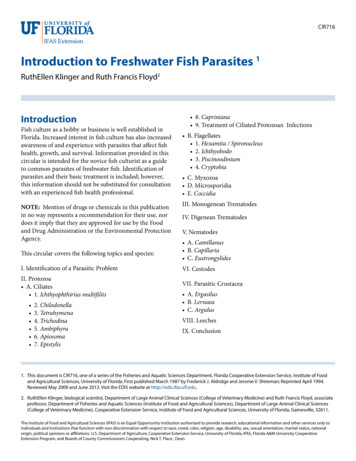
Transcription
The OriginalBeat The Fish Guide
The Original Beat The Fish GuideAuthors Note in 2016The follow ing Beat The Fish strategy guide w as actually the fir s t p ie ce I e v e r d idfo r t h is s it e in t h e s u m m e r o f 2 0 0 5. I've fixed it up graphically and structurally(seriously , I w as using Frontpage 20 0 3 until recently ), but 95% of the text rem ainsthe sam e as it did w hen I put it out in those halcy on online poker hey day s.It not only rem ains special to m e for sentim entality , but the advice I doled out aftera couple y ears of online poker under m y belt is still going to be relevant today . I feellike I'm a better w riter today that I w as m ore than a decade ago, but the strategy isstill solid.Be g in n e r s ca n s t ill p ick u p a t o n and I think m ore advanced play ers w ill stillgleam a trick or tw o to earn a little extra profit.A lot of the guide m a y s e e m lik e co m m o n s e n s e to today 's play ers, but keep inm ind that in 20 0 5 quality No-Lim it Hold'em strategy advice w as still fairlyscarce. Guides designed specifically for beating the w ild online tables of the dayw ere virtually nonexistent.That's w hat m y unique angle w as: y ou m ight know how to play , but y ou need toadopt an entirely new set of rules for "the fish". I hope y ou enjoy it as m uch as Ienjoy ed sharing it w ith hungry play ers all those y ears ago.2
The Original Beat The Fish GuideTable of ContentsAuthors Note in 2016 . 2Introduction . 4Part One: Where Did Online Poker Fish Come From?. 5Enter online poker . 5Enter the fish . 6Part Two: Preflop Play . 8Hand Selection . 8Suited Connectors . 9Playing Any Pocket Pair . 10Play the Opposite Style of Your Opponents . 10Part Three: Preflop and Postflop Play . 12Proper Play: Preflop . 12Proper Play: On the flop . 13The Board Flops a Pair . 14Don't Slowplay Very Often . 14Letting Big Slick Go . 15Preflop and on The Flop: Alternative Method . 16Part Four: The Turn and River. 17Playing Draws . 17Proper Play: Turn and River . 18Checking on the River . 18Checking on the Turn . 19Betting the Minimum . 20Know When You're Beaten . 20Is Your Hand Counterfeited? . 21Discipline . 213
The Original Beat The Fish GuideIntroductionWith the surge that online poker has experienced over the past 2-3 years, the industryis at an all-tim e high. Whether players specialize in Texas Hold'em , Om aha Hi/ Lo, 7Card Stud, or even 5 Card Draw, a full table is never m ore than a walk from the couchaway. Unfortunately, experienced poker players have alm ost shied away from theonline poker infiltration because of the recent in flu x o f in e xpe rie n ce d p o ke rp laye rs .These clueless internet players are com monly called "fish" or "donkeys". Isn't theterm "fish" a whole lot cooler, though? I m ean, why pick on poor donkeys? If you callthese degenerates fish, you can naturally assum e the poker "shark" nicknam e. W h op re ys o n d o n ke ys ? And what would we call our site - Beat The Donkeys?Anyway, while these unsuspecting players will often pay off better players with bighands, they will also draw out on those better players against the odds. Not only canthis cost you a big chunk of your stack, it can cost you your patience and discipline asyou go from proper poker play to the dreaded lan d o f tilt - a situation where pokerplayers lose their cool and thus play poorly after a bad beat.Our strategy tutorial seeks to outline sim ple yet effective m ethods to beating the fish,which allows you to keep playing your gam e.4
The Original Beat The Fish GuidePart One: Where Did Online Poker Fish Come From?The explosion of televised poker tournam ents and lipstick cam eras has ushered in anew era of poker popularity. Thousands of new players flocked to the gam e, m ainlythe Texas Hold 'em variation, hoping to em ulate their TV heroes for fam e andfortune.The revolution of televised poker created the boom, piquing the interest for the gameamong many who have never heard of the game beforeThe logical starting place would be the lo cal card ro o m , where new players can tryto im prove their gam e against real players. Unfortunately, casinos don't exist in m anyplaces of the country. Others m ay feel too intim idated to enter a physical cardroomfor the first tim e.Enter online pokerBeginning in the early 20 0 0 s, startup com panies began to cash in on poker's newpopularity and create online poker room s. New poker prospects could play onlineanonym ously from anywhere at anytim e. J ust fund your account, choose your gam e,and play your cards against th o u s an d s o f re al p laye rs from all over the world.Over these 4 years, online poker has becom e a boom ing industry. New players who'vejust watched D an ie l N e gre an u crush the com petition at a WPT event rush over totheir computers to deposit with the poker room with the coolest com m ercial.5
The Original Beat The Fish GuideThousands of inexperienced players can enter any online gam e so long as they havethe buy-in.Enter the fishThis is the new breed of online player. They've watched Ch ris Mo n e ym a ke r takehom e a couple m illion bucks by putting in his whole stack with nothing. They'vewatched professionals raise with A-5 offsuit from late position and catch two fives onthe flop. Why can't they do it, too?Usually they're harm less. Players who know their stuff, read and study poker books,and stay on top of their gam e can m ake a killing off of this type of player. They'll bluffoff all of their chips when you have the nuts and you'll love it. They're also dangerousand can put you off your gam e.How m any tim es have you been on Party Poker playing 1-2 No-Lim it Hold 'em andraised 4x the big blind with A-K and get called by A-5 only to watch the flop com e A6-5 rainbow. "Great!", you're thinking as you reraise your clueless opponent for all hischips. You don't catch a K on the turn or river and you're left wondering w h y h es taye d in th e h an d at all.The combination of televised poker, with all its glamour, and the availability of online pokercaused the surge of the fish to the virtual felt, looking to follow in the footsteps of their heroes6
The Original Beat The Fish GuideYou try to shrug it off and you get dealt pocket Aces the very next hand. Your fishybuddy has position on you so you just call the big blind from early position. Everyonefolds to him who m akes the m inim um raise.Why do these players do that so often? What's the point? How m any tim es have youseen this open up the betting action and the sm ooth caller co m e s back o ve r th eto p of the m inim um -raiser for a huge raise? Everyone folds. Why don't they eithercall or m ake a real raise? Or why don't they go find a Lim it gam e if they're going toplay like that? Oh, well.Anyway, everyone folds back to you and you just call the m inim um raise hoping totrap the fish. The flop com es J -4-9 rainbow. Another seem ingly great flop for you.You m ake a good pot-sized bet here and the fish com es over the top and raises you forall you've got! You decide to call as he turns over J -2 offsuit.Finally you've got him ! The turn brings a K and the river brings a deuce. You poundyour com puter m onitor as you click to exit the poker room . You're d o w n 4 0 0 w ithtw o p re m iu m h an d s ."Why m e?", you ask the Poker Gods in the sky. It happens. These are real hands thatI've been involved in, and som ething sim ilar w ill p ro bably h ap p e n to yo u (if ithasn't already) if you play online poker m uch. My goal is to teach you how to keepthese situations to a m inim um , and if it does happen anyway, how to deal with itwithout blowing off anym ore of your chips.Th e ke ys are h an d s e le ctio n , p ro p e r p lay, an d d is cip lin e .7
The Original Beat The Fish GuidePart Two: Preflop PlayHand SelectionI'm sure that you've read about hand selection and looked over your favorite author'sstarting hand guide. It will tell you the re co m m e n d e d h an d s that you should playfrom early, m iddle, and late position. There are exceptions, but theirrecom m endations are usually a very good guide to use. If you want to keep yourselfout of trouble and stay above the gutless play of the online fish, you'll take your tightaggressive author's word and stick to good starting hands.The key to successful online poker strategy is having a solid preflop hand selection. If you consciously try tonot get involved with weak hands, you will avoid many marginal (and potentially expensive) situationsI even kept a photocopy of Matth e w H ilge r's starting hand guide from InternetTexas Hold 'em next to m y com puter for a while. And rem em ber, we all play garbagelike J -7 offsuit at tim es, but try to keep those tem ptations to a m inim um . It'll save youa lot of m oney in the long run.In Beat Texas Hold 'em , Tom McEvoy suggests that "it is unprofitable over the longrun to play anything other than Aces, Kings, AK, and som etim es Queens from thefirst position." He's right. Position is power in hold 'em .8
The Original Beat The Fish GuideYou can loosen your starting hand requirem ents as you get closer to the button, butplay ve ry s e le ctive ly fro m e arly p o s itio n . You'll have to act first, and you won'tknow where you stand unless you're holding strong cards.Most of your opponents will be playing a com bination of good starting cards (evenm aniacs can wake up with AA) and bad cards. You'll o n ly be p layin g th e go o dcard s . Don't sink to their level because you'll probably be stuck with a borderline callthat could cost you a lot of m oney.More tips on Hand Selection: Te xas H o ld 'e m H an d Stre n gthSuited ConnectorsEven though you'll be playing big cards m ost of the tim e, keep an eye on the pot whenyou're in late position. This is a great tim e to play suited connectors if 4 or 5 playersare seeing the flop with you.The pot odds justify a call from you in this situation, plus these types of hands canturn into real m onsters if you hit the right flop. If you've been showing youropponents good cards, you m ay even co n s id e r a rais e in this situation. Youropponents will put you on a couple of big cards, and it can pay off when you hit twopair or a set on the flop with your 4-5.More tips on Suited Connectors: Sm all Su ite d Co n n e cto rs9
The Original Beat The Fish GuidePlaying Any Pocket PairA couple of table situations m ake it profitable to play sm all and m edium pocket pairs(2-2 through 10 -10 ) from any position. If you're in late position and you have at least4 or 5 callers ahead of you, definitely play any pocket pair.Playing small and mid pocket pairs can be an effective online poker strategy, but you need to be mindfulof the odds and your position at the tableAlso, if your table is passive and you don't encounter a lot of preflop raises, than youm ight consider playing any pocket pair from m iddle and late position. J ustrem em ber, if you don't have an overpair to the board on the flop, NO SET, NO BET!More tips on Pocket Pairs: Sm all Po cke t PairsPo cke t JacksPo cke t Kin gs an d Qu e e n sPlay the Opposite Style of Your OpponentsWhen your table is full of stupid players who are hitting big hands with trashcards, yo u m igh t be te m p te d to play those sam e trash cards hoping to hit thosem onsters, too. You can try it. But the problem is that m aniacs and fish like tointim idate other players by constantly raising the pot preflop. It's going to cost you tosee the flop, and m ost of the tim e you're not going to hit anything with trash hands.10
The Original Beat The Fish GuideAs Doyle Brunson recom m ends in Super System 2, you usually want to be playing theopposite style of the opponents at your table. If your table is full of wild loose players,you want to tighten up and wait for the right cards to snap them off. I don't suggestgetting involved with m ediocre hands and trying any fancy plays at m ost loose onlinetables.Your opponents aren't going to pay attention, and will probably call you down withany two cards. Doyle's advice also works well if you're playing at a tighter site likeUltim ate Bet or Full Tilt (editor's note: rem em ber those guy s?). At a table full of tightplayers, I often m ix it u p with lots of pot-sized raises from late positions. Most of thetim e you'll pick up the blinds and if you do get called, you can usually win it on theflop if all blanks fall.Ove rall Pre -flo p Strate gy: Good starting hands are the first defense against bad online playersBe very selective from early positionLoosen up your starting hand requirem ents as you gain positionConsider staying in with suited connectors from late position with lots ofcallersPlay sm all and m edium pocket pairs in the right situations and rem em ber: noset, no betDon't sink to the bad players levelPlay the opposite style of the rest of the table11
The Original Beat The Fish GuidePart Three: Preflop and Postflop PlayProper Play: PreflopThe consensus am ong No-Lim it Hold 'em experts is that a "s tan d ard " rais e is 3-4tim es the am ount of the big blind. I agree for real cardroom poker. But online againstloose players, one of the best defenses you have is increasing the am ount of your"standard" raise, possibly to 5-6 tim es the big blind. If your online poker site has a"Bet Pot" button, raise at least by this am ount.By doing this, you m ake it a little harder for bad players to stay in with bad cards thatwill draw out on you. I definitely recom m end a larger raise for tricky pocket pairs likeK-K and Q-Q. If two players call your raise instead of five when you have K-K and anAce com es on the flop, you are m ore likely to still be holding the best hand.Be flexible with your preflop raise sizes. If you can get away with making 6 or 7x raises,then by all means do it with your big hands and charge the fish the maximum to follow you to the flopI can't stress this enough about online poker: RAISE YOUR BIG HANDS AND RAISETHEM HARD! I've learned to rarely slowplay anything at all unless I have theabsolute nuts. Slowplaying will just ge t yo u in tro u ble and often lose you a big pot,especially online. Lee J ones advocated this sam e style of play in Winning Low-Lim itHold 'em . He's right.Sure, you're often going to end up winning a sm all pot when no one wants to call yourraise. Why get greedy? You won the pot, didn't you?IT'S ALW AYS BETTER TO W IN A SMALL POT TH AN LOSE A BIG ON E!12
The Original Beat The Fish GuideTell m e a single tim e where that isn't true.More tips on Pre-flop Play : Playe r Ad vice : Ge ttin g Starte d Again s t Fis hTh e Facts o n Min im u m Rais e sSte alin g th e Blin d sProper Play: On the flopOkay, so you're playing the right cards and raising them before the flop, now what?After you judge your own hand, you've got to get good and reading the board andreading your opponents. Always look for straight and flush possibilities.Think of what the best possible hand is on the flop and what your opponent is likelyto be holding. Look for straight and flush possibilities. If you've been studying theirplay, you should be able to m ake a fairly good read on their possible hands.If you think that you have the best hand on the flop (usually at least top pair with agood kicker), protect it against loose opponents. Why let them draw out on you forcheap? If I'm heads-up and out of position on the flop holding A-K offsuit with boardof A-J -8 with two diam onds, I'm going to m ake at least a pot-sized bet to try to m akem y fis h y o p p o n e n t p ay for his flush draw. The sam e thing goes if you see astraight draw on the board.Protecting your hand on the flop is essential to your success. If the fish is drawing, make sure to chargethem properly. If they are too stubborn to give up, show them how stubbornness can be very expensive13
The Original Beat The Fish GuideLots of players will play anything from any position, so no m atter how unlikely itseem s, you have to protect against any possible draw. If you have a strong hand withm ultiple opponents and two suited cards or two connected cards come on theflop, yo u 've go t to be t at it. And bet even m ore with m ultiple opponents.There is no worse crim e than allowing your opponents to draw out on you for cheapor for free. Don't do it!The Board Flops a PairBe very careful when the board flops a pair, three suited cards, or three connectedcards. A flop of J -4-4 rainbow m ight look harm less, but m any bad players have the"Ace-anything" m entality and will routinely play A-4. Don't bet m uch at that pot withA-J .Also, one or m ore of your opponents is likely to have flopped a big hand with threesuited or connected cards on the board. Pe o p le like to p lay s u ite d an dco n n e cte d card s , so I'd play extrem ely cautiously, especially if m any opponents areseeing the flop with you.If anyone bets a substantial am ount in this situation and you don't have the nuts or adraw to the nuts, you've got to lay your hand down.Don't Slowplay Very OftenUnless you have the nut straight, nut flush, a full house, or better - don't slowplay onthe flop! I will bet out the top set routinely, unless it is an unsuited board with nostraight possibilities. I'll check it down then. The fish will draw to anything. D o n 't le tth e m d o it fo r fre e .14
The Original Beat The Fish GuideSlowplaying is a legit part of online poker strategy, but make sure not to use it too often, or you willfind yourself in weird spots, facing huge bets, and having no idea if your hand is any goodIf you do hit som ething huge on the flop, then you've GOT to check it down. You'veessentially crippled the possibilities of there being other good hands out there. If youwant any action on your hand, check your hand and le t th e m catch u p a little onthe turn and river.More tips on Slow play ing: Slo w p layin g o n th e Tu rnPo cke t Ace s ( AA)Letting Big Slick GoA-K, often referred to as "Big Slick" is a d raw in g h an d , not a m ade hand. It's a greatdrawing hand because when you pair up the board, you're going to have top pair withtop kicker. But you're only going to hit a pair on the flop with A-K about 1/ 3 of thetim e. The other 2/ 3 of the tim e if som eone bets, just fold and be done with it.Big Slick is nothing without help from the board, unlike A-A or K-K. If you don't pairup on the flop, you can try to take a stab at the pot if you're heads-up and in position.Otherwise, check it down and fold to m ost bets. Why keep drawing with a very thindraw? That's just a bad way to lose m ore m oney.15
The Original Beat The Fish GuidePreflop and on The Flop: Alternative MethodMy poker m entor, who's been playing poker for over 40 years, told m e about aninteresting m ethod that helped him get through streaks of really bad beats.Som etim es he'll play No-Lim it hold 'em without eveer raising before the flop.He'll s m o o th call e ve ry h an d he intends to play, regardless of how huge it is.Of course if som eone raises and he's holding pocket Aces, he'll probably reraise himback. But when he plays like this, he'll usually just call with everything. He does thisfor one sim ple reason:It teaches you to rely on the flop and read your opponents properly. It can also saveyou som e m oney if the flop turns out really ugly for you.J ust call with all of your hands and read the flop. If you don't get any help, obviouslyyou're out. If you do get help but the board is dangerous, see what the other playersdo. If they bet anything substantial, you m ust entertain the possibility on folding yourhand.An advantage to this m ethod of play is when you're holding K-K or Q-Q and the flopcom es out with an Ace. You check and fold to a decent-sized bet. You saved m oney bynot raising preflop. This can be a d an ge ro u s w ay to p lay if you don't read the flopright, but it can be a good way to learn to read your opponents on the flop and cansave you m oney in certain situations.Ove rall Strate gy o n th e Flo p : Always raise your strong hands, especially at loose tablesConsider raising at least 5-6 tim es the big blind.Bet out hard on the flop to keep draws playing against the oddsBe careful with a dangerous board against bad players - they play any twocardsDon't slowplay unless you have the absolute nutsLet go of A-K im m ediately if you don't flop anythingConsider only calling everything preflop for awhile if you're on a bad beatstreak16
The Original Beat The Fish GuidePart Four: The Turn and RiverPlaying DrawsEssentially, I recom mend a Flo p It o r Fo ld It strategy for loose online hold 'em especially for beginners and interm ediate players. If you keep playing a drawinghand, you're usually not going to hit your draw and you'll usually be going against theodds to try.If you flop an open-ended straight or flush draw, you're a little worse than a 2-to-1favorite to hit your hand if you stay in to the river. If you m ake a weak call on the flop,m iss your draw on the turn and fold, then you m ight as well have calculated yourself a4-to-1 favorite for seeing just one extra card.Playing draws incorrectly can be a very costly mistake. Make sure you know the exact oddsand have a proper plan before putting your chips in the middleYou're usually going to need a couple of other players calling on the flop to get theright pot odds to continue with your draw. And I don't recom m end d raw in g o u t o fp o s itio n . If you're last to act, at least you have one advantage over your opponents.Plus you can occasionally m ix it up by raising with your drawing hand. This will m akeplayers tend to check to you on the turn, allowing you to check behind them if youm iss your draw and bet again if you hit it.One note on draws: drawing to the nuts or having two overcards greatly increasesyour hand's value. For exam ple, if you have A-K suited and flop another two cards of17
The Original Beat The Fish Guideyour suit, you'll have a draw to the nut flush and also outs to hitting your overcardsand winning the pot.More tips on Play ing Draw s: Be ttin g Yo u r D raw sProper Play: Turn and RiverPlay in Texas Hold 'em , especially No-Lim it, is defined by the flop. This is where youwant to take control of the hand and you'll pick up lots of pots by winning it rightthere. With m any players drawing to straights and flushes, you also need to learnto ad ju s t yo u r p lay on the turn and river.On the flop, you're going to bet out with suited or connecting cards on the board.When you're last to act, m any opponents on a draw will m ake the weak play ofchecking and calling your bet. If the turn com pleted the flush or straight and youropponent has it, he'll probably check to you again hoping to check-raise you or trapyou into betting again on the river. Don't fall for it.I'll often check behind them and m ake them bet on the river if they have a good hand.If he m akes a big bet and there's an obvious straight, flush, or set out there and youcan't beat it, think about laying your hand down.If it's a pretty sm all bet and the pot is a decent size, you'll probably want to call andkeep him honest. As Lou Krieger suggests, you can't play being afraid of the nuts allthe tim e. If you do, you're giving up too often.More tips on the Turn and River: Rais in g o n th e Rive rChecking on the RiverA very im portant play is knowing when to ch e ck o n th e rive r. If you're first to actand you put your opponent(s) on a m issed draw, there is no reason to bet out on theriver. If you bet and they're holding a m issed draw, they're just going to m uck theirhand.18
The Original Beat The Fish GuideThere is no reason to shy away from checking on the river. In most instances, by this point your opponenteither has a hand that can't call or he is looking to trap.This is not to say that you should never value bet the river, but checking has its advantages.However, if you check, you send the signal that m aybe you m issed a draw, too. Thisgives your opponent th e o p p o rtu n ity to blu ff and you can m ake som e extra m oneyin the end. If they check behind you, you win the hand anyway and the pot is thesam e size as if they had folded their hand to your bet.Checking on the TurnThis is a play that I like to use when I have a strong hand (usually at least two pair)and I don't think m y opponent can beat m e. If I'm last to act, I'll bet on the flop. Thenwhen I get checked to on the turn, I check behind him . This will probably m ake youropponent think that yo u h ave a bu s te d d raw and you can m ake som e extra m oneywhen you raise him on the river.More tips on the Turn: Slo w p layin g o n th e Tu rn19
The Original Beat The Fish GuideBetting the MinimumAnother opportunity for a valu e be t com es on the river when you know that youhave the best hand but you don't think anyone else has m uch. Try be ttin g th em in im u m am o u n t. This can m ake your opponents suspicious and could induce araise or they m ay have som ething good enough to call with.At least you m ake a little extra in the end rather than betting your opponents out ofthe pot.Know When You're BeatenKnow when you're beaten on the river. I see players tim e and tim e again calling a bigbet with two pair or a set on the river when there's four to a straight or flush showing.That's not a good play.The odds are very high that som eone has one card to com plete the straight or flush,especially with m ore than one opponent. I know that they shouldn't have stayed inwith the cards necessary to com plete an 8-high straight, but they do. Usually yo us h o u ld n 't call a s u bs tan tial be t in this situation without that flush or straight.One of the key virtues of all successful poker players is the ability to recognize when they are beatand let go of their hand. As they say, there is little point in throwing good money after bad20
The Original Beat The Fish GuideIs Your Hand Counterfeited?Know when your hand is counterfeited - decreased in value by the board. If you get tosee a free flop with 5-3 and the board com es J -5-3, you're going to have a prettystrong hand. However, if the turn com es with another J , yo u d o n 't ge t cre d it fo rh avin g th re e p air! You m erely have two pair - J acks and fives. Another holding aJ ack has you beaten.DisciplineThis is the one facet of poker that is m ost under your control and yet can be the m ostdifficult to m aster for som e players. You m ust have discipline and patience to playwinning poker. You m ust have the patience to wait for the right hands, andthe d is cip lin e to s tay o ff tilt.Getting bothered by a player or angry by how the last hand turned out can be theundoing of your hard day's work of poker.It is difficult to com bat and we all go on tilt at tim es, but you m ust learn to let theprevious hand go before playing the next one. If you can't, just sit out and walkaround for a few m inutes. The gam e will be there when you get back. Or try switchingtables. In all honest
popularity and create online poker rooms. New poker prospects could play online anonymously from anywhere at anytime. Just fund your account, choose your game, . You decide to call as he turns over J-2 offsuit. . This is a great time











